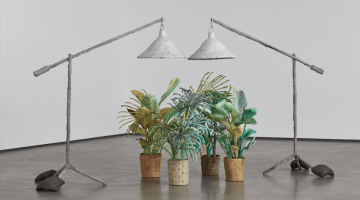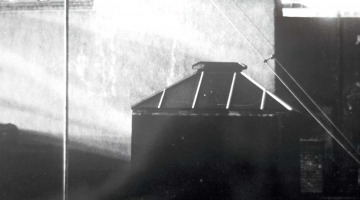Contributed by Leora Lutz
Last Tuesday I left Ben Barretto’s show at The Popular Workshop (TPW) excited to write about his work. I was even more excited after looking at his website of past work, specifically the kinetically generated paintings and sound installations. Although the current works at TPW are all pieces that the artist equates with painting, it is worth mentioning his previous work – which was explained to me as “action-oriented”, because this informs his current practice, literally and conceptually. His earlier works are assemblages of various industrial materials such as industrial tubing, art and domestic repair materials such as plaster trowels and wood beams, rubber balls, fake flowers, bright industrial string, tape rolls and instruments such as electric guitars or keyboards – all generating sound from kinetic play that is driven by a small motor, or by gravity in some instances. The pieces are held together precariously, and they look as if they might wobble apart, or crumble at the next move. But they don’t, and when they do move, the sounds are a mixture of melody and real-life noises. I am particularly fond of his Fan Bands. No people are present, in any of these. Instead, fans play the music…I highly recommend spending time with these installations, as they are telling addition to the dialog that is taking place with the static two-dimensional works currently on view in the “Self Help” exhibition at TPW.
The exhibition at TPW is a generous yet concise selection of works that show an exploration and a relational overlap of the artist’s diverse choice in materials and practice. Inherent throughout the work is material exploration and a process of making that embraces imperfection while at the same time relishes compulsion. Hence, the title of the exhibition “Self Help” which may imply a psychological spell with which the artist is currently engrossed in his practice.
Barretto’s fascination with American sports and other athletic activities is driven by an aesthetic admiration for the lifestyle and the utilitarian nature of materials. In a sense, his methods become metaphorical re-appropriation of specific activities in order to call to question the formal traditions of the act of painting and to revisit it in a contemporary vernacular. At work in his practice is a mixture of activities and ways of completing works, from action painting, to weaving, to piece work and assemblage. In addition to paint and canvas, previously worn tear-away pants and retired rock-climbing ropes are two predominant materials that Barretto uses to make fabric “paintings” and weavings respectively.

Painting Painting S19, 2013. 72″ x 48″ (diptych). oil on canvas. Photo courtesy of The Popular Workshop
His “Painting Paintings” are a kind of meta-action series of works. One canvas is painted with thick paint, then pressed face-to-face with another canvas, and then peeled apart. Next, Barretto uses the corner of the canvas he is holding as a “tool” to scrape at the other canvas while it is laid on the floor. He pushes the paint off and allows it to build up on the corner of the canvas he is scraping with, and leaves it there to dry. Messy and odd, the small hills of paint in the corners are remnants of the action that took place to make the patterns on the canvas and are an accumulation of action gathered in one static lump. Up close, the viewer can see the tiny dallops that are a result of the two canvases being pressed together, which creates recognizable veining pattern on the surface. The paintings are very textured, yet the impasto is slight or shallow overall. Stains and streaks of multiple colors can be seen in the channels that are left behind where the paint has been scraped away. The line work and geometric “drawings” are abstract compositions that are reminiscent of energy, yet strangely static – locked into Barretto’s decision to stop moving at the moment we are now privy to with these works. His choice of color is informed by the colors found in the rope and cloth pieces in the show. The diptych, “Painting Painting S19” – a dark murky green with flecks of yellow, orange and blue peeking through the scrape channels – is in direct conversation with the cloth piece “Tear Away” situated on the perpendicular wall of the gallery.

Tear Away, Three on Three, 2013.
24″ x 36″ and 24″ x 30″
polyester, cotton, press studs on stretched canvas. Image courtesy of The Popular Workshop
“Tear Away” is made from athletic tear-away pants, in addition to 4 other works in the show using the same stretched-cloth process. The tear-away pants are cut, sewn together and stretched over pre-stretched canvas. The pants are arranged in geometric compositions that take the existing piping or lines of snaps on the pants as organizational cues. The result is a containment of lines that are bound up in the canvas substrate. The pieces seem tight and constrained, which is in direct opposition to the flexibility that this type of pant is expressly made to accommodate and is originally intended for. Furthermore, the binding to the canvas affixes them in a way that subverts their original purpose – which is to be removed quickly and easily. Not anymore; permanently affixed now, the material is rendered useless and formalized into a static object. It too, like the paintings, is a moment of perpetual rest after the activity – each move decided and the configurations placed. The diagonal ruching and asymmetrical synching of the dark green fabric along the reddish pink grosgrain snap ribbon in “tear Away” lends an uncomfortable theatrical connotation. All the more fitting (no pun intended) with the strange liminal space between constraint and abandon that the work in “Self Help” implies.

Desert, 2013. 44″ x 50″. Used climbing rope, twine and metal. Image courtesy of The Popular Workshop
The third suite of work in the show is comprised of three weavings made from retired rock-climbing ropes. I use the word retire here, because apparently these ropes should be discarded after a certain number of uses/allotted wear and tear, in order to ensure maximum safety potential. Here, the rope then not only becomes a reused rope, but a reused rope which is discarded by way of a matter of life and death. Because of this reason the rope and the weavings that are made from it suddenly carry a much more profound meaning than the other works in the show. These ropes are no longer eligible to hold the weight of a person while suspended during the activity of conquering nature (just saying this makes the rope seem utterly necessary and at the same time ridiculous), and neither are these weavings usable as blankets, clothes or even rugs. Each piece is woven on a large frame loom. The tops are threaded through aluminum rods from which the weavings hang against the wall. The warp(1) of the pieces are thin, industrial string which hangs like dangling, lank hair about six inches above the floor – neither grounding nor elevating the work, but rather leaving it suspended in limbo. Of the three weavings, I was particularly drawn to the solid orange one entitled, “Desert”. Along the course of the weaving, the eye encounters crevasses that are the result of large knots tied in the back. This is the only monochromatic piece in the show, and admittedly, I am drawn to monochromatic things in general, and I also appreciate work that blurs the line between minimalism and compulsion. For its poignant material meaning, and for the aesthetic reasons I mentioned, I claim that this is the strongest piece in the show.
However, noting again the title of the exhibition: “Self Help”, and the title of another weaving: “Inner Self”, perhaps again we can return to the concept of the process in the work and find Barretto closely connected with the weavings. They come forward as the work with most potential as a lead-in or departure point to future works, while the other two series seem resolved and have potential for multiple iterations. In this exhibition, a life-progression has occurred, from the mirror stage (recursion paintings), to virility (tear-away pants) to retirement (weak rope). By using some now-traditional/avant-garde tropes of painting mixed with traditional and modern craft practices, Barretto is crossing out antiquated ways of considering painting while at the same time reiterating some practices that are recognizable among post-modern circles. The work has a clumsiness to it that translates as awkwardly perfect. At the core of his practice-assortment is a successful exploration with which Barretto actually needs no help.
(1) A warp is comprised of the vertical lines of rope, yarn or string that are placed on a loom either with tying or with wrapping. The weft, is the material that is passed over and under the warp to create the weaving.
For more information visit The Popular Workshop.





